New York State Office of Parks, Recreation and Historic Preservation facts for kids
| Agency overview | |
|---|---|
| Jurisdiction | New York |
| Headquarters | 625 Broadway Albany, NY 12207 42°39′09″N 73°44′55″W / 42.652366°N 73.748592°W |
| Employees | 1,737 permanent 4,500+ seasonal (2014) |
| Annual budget | $385,693,500 USD (2014-15) |
| Agency executive |
|
| Parent department | Executive Department |
| Key document |
|
The New York State Office of Parks, Recreation and Historic Preservation (NYS OPRHP) is a state agency in New York State. Its main job is to manage and run the state parks and historic sites across the state. As of 2014, NYS OPRHP takes care of almost 335,000 acres (about 523 square miles) of public land. This includes 180 state parks and 35 historic sites. More than 62 million people visit these places every year!
Contents
History of New York State Parks
The agency we know today as the NYS OPRHP was officially created in 1970. However, the story of state parks and historic sites in New York began much earlier, in the late 1800s. Before NYS OPRHP, different groups and smaller state offices managed the parks. The new agency grew from the work these earlier organizations had done.
First State Parks Created
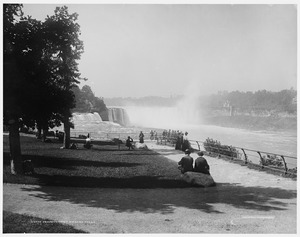
New York State started buying land for parks in 1883. That year, Governor Grover Cleveland signed a law to get land near Niagara Falls for a "state reservation." Two years later, the Niagara Reservation opened to the public. Today, it's known as Niagara Falls State Park. This park is thought to be the oldest state park in the United States. It was also the first park created by the state buying private land for public use, even if the owners didn't want to sell.
The state continued to add more parks in the early 1900s. Some of these included the St. Lawrence Reservation in 1896, Letchworth State Park in 1906, and Fire Island State Park (now Robert Moses State Park) in 1908. Other important additions were John Boyd Thacher State Park in 1914, Enfield Glen State Park (now Robert H. Treman State Park) in 1920, and Allegany State Park in 1921.
During the 1910s and 1920s, people worked together to protect parts of the Hudson Palisades. These cliffs were being damaged by quarrying (digging for rocks). This effort led to the creation of parks like Bear Mountain State Park and Harriman State Park.
New York State Council of Parks
In the early days, there was no single group to manage all the state parks. Instead, different regional groups, like the Palisades Interstate Park Commission, ran their own parks. To help coordinate everything, the New York State Council of Parks was formed on April 18, 1924.
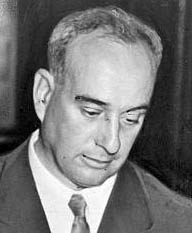
The council's job was to plan how parks would be developed and to set rules for all state-owned parks and historic sites. Governor Alfred E. Smith supported its creation. Robert Moses helped plan the council and became its first commissioner. He stayed in charge of the council until 1963.
The council included people from different park commissions and organizations. It was the main group overseeing park management in the state for a while. Today, the council is called the New York State Council of Parks, Recreation and Historic Preservation. It still exists as an advisory group, meaning it gives advice and guidance.
Here are some of the groups that are part of the council today:
- New York State Office of Parks, Recreation and Historic Preservation
- New York State Department of Environmental Conservation
- New York State Board for Historic Preservation
- Allegany State Park Commission
- Central State Park Commission
- Finger Lakes State Park Commission
- Genesee State Park Commission
- Long Island State Park Commission
- New York City State Park Commission
- Niagara Frontier State Park Commission
- Palisades Interstate Park Commission
- Saratoga-Capital District State Park Commission
- Taconic State Park Commission
- Thousand Islands State Park Commission
Division of Parks and the Great Depression
In 1926, New York's state government was reorganized. This created the New York State Conservation Department, which included a Division of Parks. This new division took over managing New York's parks and historic sites. The Council of Parks continued to work within this new division. It also gained the job of planning road improvements to make it easier to get to the parks.
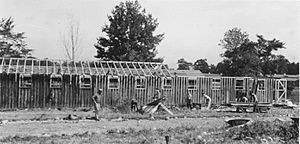
The Great Depression in the 1930s meant less money for New York's state parks. However, this period was also a time when many park facilities were built. Workers from federal programs like the Civilian Conservation Corps helped a lot. They cleared land, did maintenance, and built roads, trails, golf courses, buildings, and furniture for the parks. This work continued through the 1930s and early 1940s.
By 1941, New York State managed 74 parks. These parks welcomed 20 million visitors each year. In 1944, 27 State Historic Sites were moved to the New York State Education Department. They were returned to the Conservation Department in 1966. At the same time, the New York State Historic Trust was created to help manage them.
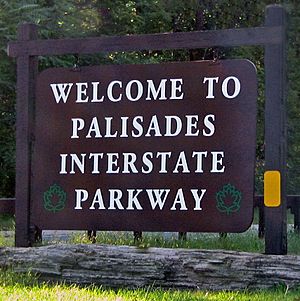
After World War II ended, New York's park system kept growing. Building or finishing parkways, like the Palisades Interstate Parkway, was a big focus in the 1950s. As more people visited state parks after the war, the state looked for new land to create more parks. More money for parks in the 1960s allowed the state to buy several large areas for park development. The state also started adding new types of facilities, such as boating areas, and even created parks within New York City.
NYS Office of Parks, Recreation and Historic Preservation is Formed
A big change in New York's park management happened in 1970. A new law created the New York State Department of Environmental Conservation. This department took over most of the old Conservation Department's jobs. However, managing state parks and historic sites became the job of a new, independent agency. This agency was first called the New York State Office of Parks and Recreation.
In 1972, the agency was given direct control over New York's park lands. The State Council of Parks and regional commissions continued to give advice. In 1981, the agency's name was changed to its current form: the New York State Office of Parks, Recreation and Historic Preservation (NYS OPRHP).
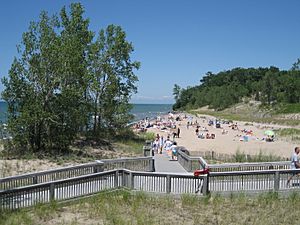
The state park system grew quickly during former governor George Pataki's time in office. Between 1995 and 2007, Governor Pataki and parks commissioner Bernadette Castro opened 28 new state parks. While this was good for conservation, it also meant more costs for NYS OPRHP. The money for running the parks stayed the same.
In 2010, New York faced a money crisis. It was announced that 55 state parks and historic sites might close. Luckily, these closures were avoided. The money problems were solved by reducing staff and hours at many parks. Some internal facilities, like campgrounds and golf courses, were closed. Also, fees for using the parks went up.
The 2010 money crisis meant less funding for repairs at New York's parks. To help fix an estimated $1 billion worth of needed repairs, $143 million was made available in 2012. This money came from state, federal, and private sources. In 2015, the state announced a plan to spend $900 million by 2020 on repairs at parks and historic sites across the state.
Park Facilities and Features
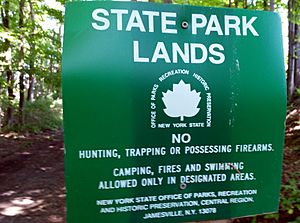
As of 2014, the NYS OPRHP manages many different types of facilities for visitors to enjoy. Here are some of them:
- 335,000 acres (about 523 square miles) of public land
- 180 state parks
- 35 state historic sites
- 67 developed beaches for swimming and relaxing
- 36 swimming pools
- 27 marinas for boats
- 40 boat launch sites
- 29 golf courses
- 817 cabins and rental houses
- 8,355 campsites for overnight stays
- 2,000 miles of trails for hiking, biking, and more
- 18 nature centers to learn about local wildlife and plants

